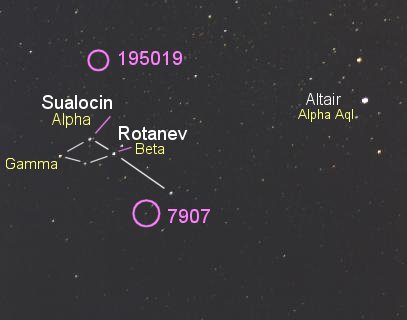 HR 7907 is classed as a wide double star, which would make it odd
as a planet host. True companionship, however, is unlikely.
HR 7907 is classed as a wide double star, which would make it odd
as a planet host. True companionship, however, is unlikely.
THE PLANET
The lower circle shows the location of the class F subgiant star HR 7907,
found in the constellation Delphinus. The
planet, whose mass is at least 1.84 times that of Jupiter, orbits
with a period of 386 days at an average distance of 1.12
Astronomical Units (168 million kilometers, 104 million miles),
just 12 percent greater than the Earth's orbital size. A
significant orbital eccentricity causes it to range between 1.46
and 0.78 AU from the star (the latter just nine percent greater
than the diameter of the Venusian orbit).
|
 HR 7907 is classed as a wide double star, which would make it odd
as a planet host. True companionship, however, is unlikely.
HR 7907 is classed as a wide double star, which would make it odd
as a planet host. True companionship, however, is unlikely.
 HR 7907 is classed as a wide double star, which would make it odd
as a planet host. True companionship, however, is unlikely.
HR 7907 is classed as a wide double star, which would make it odd
as a planet host. True companionship, however, is unlikely.